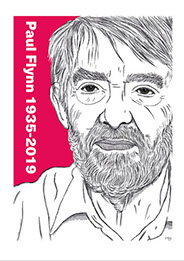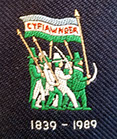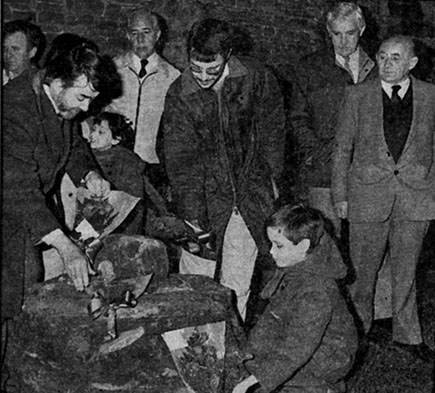
PAUL FLYNN Cyfiawnder, Heddwch ac Rhyddid
The View from across the Editor's Desk

Justice, Peace and Liberty were the words that came to my mind during Paul’s funeral held at St. Woolos, Newport’s Cathedral on
Friday 22nd March. These ‘watch words’ of the early nineteenth radicals, sum up the concerns that drove Paul into public life and steered his political course through a lifetime of political campaigns, service in local government and thirty-two years as MP representing the people of Newport West.
 Paul was especially fond of the word ‘Cyfiawnder’ - a powerful word in Welsh that means far more than ‘Justice’ does in English. It’s a weighty word embodying both righteousness and equity. In the 1980s, we gleaned from the late Gwyn Alf Williams, its importance to the Welsh Chartists and Paul, a fluent Welsh speaker, insisted that we put ‘Cyfiawnder’ at the forefront of our publicity and commemorative ‘wares’ for the 150th Anniversary of the ‘Chartist Rising’ in 1989. So on the morning of the 22nd March in tribute to Paul, I donned my 1989 Chartist tie, which is a dark blue fabric adorned with a miniature image of people carrying a flag demanding ‘Cyfiawnder’.
Paul was especially fond of the word ‘Cyfiawnder’ - a powerful word in Welsh that means far more than ‘Justice’ does in English. It’s a weighty word embodying both righteousness and equity. In the 1980s, we gleaned from the late Gwyn Alf Williams, its importance to the Welsh Chartists and Paul, a fluent Welsh speaker, insisted that we put ‘Cyfiawnder’ at the forefront of our publicity and commemorative ‘wares’ for the 150th Anniversary of the ‘Chartist Rising’ in 1989. So on the morning of the 22nd March in tribute to Paul, I donned my 1989 Chartist tie, which is a dark blue fabric adorned with a miniature image of people carrying a flag demanding ‘Cyfiawnder’.
Paul will be missed. Our thoughts go to Mrs. Sam Flynn and family. Whenever his Parliamentary duties prevented attendance at a Chartist event, Sam invariably was there in his place. She too has carried the ‘Cyfiawnder’ Flag.
When I first met Paul in the 1970s, he was briefly a dual councillor for both Newport Borough and the Gwent County and in 1979, opted to represent the County seat. Assured of Newport’s Welsh antecedents, Paul applauded the revival of the name of the ancient Welsh kingdom of Gwent, which alongside Morgannwg stood on the Celtic territory of Siluria. Monmouthshire was a Tudor fabrication and he considered the claim that it constituted an optional add-on to Wales was a Victorian fraud. We rejoiced in the recreation of a county of Gwent (1974) and had great expectation of political devolution for the territory administered through eight newly defined Welsh counties.
A ‘Young Turk’, well versed in Welsh history, he urged his elders such as Cllrs. Stuart Watson and Fred Edwards, to push on with the Chartist theme that Kenneth Budd, ceramicist artist, proposed for a town centre mural. Budd had started developing this scheme when he was researching ideas for a historical transport theme (The Old Green Crossing mural, 1972) with staff at Newport Museum (Cefni Barnett, Stephen Lock, Walter Lucas and myself) and later on with Roger Cucksey as well. Although long in gestation, Budd produced a visual narrative in 1978 that was monumental in size. One hundred and twenty feet long, compiled from broken coloured tiles and tesserae, it vividly celebrated the Chartists’ achievements. Men with pikes and guns headed for the Westgate inn, carrying aloft the five ‘points of the Charter’ enacted by Parliament over the following century. The sixth demand ‘Annual Parliaments’ lay abandoned on the floor. Moving along the column of marchers, the viewer reached the mural’s abrupt end - soldiers firing on a fleeing crowd, leaving a scene of scattered weapons and writhing bodies.
Paul recognised the need to raise awareness of Chartism amongst the Newport public. When a small group in the 1980s led by Richard Frame, secretary of the Newport History Society laid flowers in the graveyard of Newport cathedral (St. Woolos), Paul immediately recognised the symbolic importance of their action.
 In an attempt to prevent martyrdom, the military buried ten of the dead secretly at night in four unmarked graves. In defiance, local people placed flowers, accompanied by placards with verses, at the site on Flowering Sunday 1840. They continued this act of ‘Cyfiawnder’ for a number of years. Paul supported the proposal to erect an inscribed stone, commemorating all of the twenty two men slain in the battle at the Westgate Inn. The stone was unveiled in 1988 by Alexander Cordell, novelist. Annually at twilight on November 4th crowds gather to lay roses and recite poems. Paul rarely missed the event
In an attempt to prevent martyrdom, the military buried ten of the dead secretly at night in four unmarked graves. In defiance, local people placed flowers, accompanied by placards with verses, at the site on Flowering Sunday 1840. They continued this act of ‘Cyfiawnder’ for a number of years. Paul supported the proposal to erect an inscribed stone, commemorating all of the twenty two men slain in the battle at the Westgate Inn. The stone was unveiled in 1988 by Alexander Cordell, novelist. Annually at twilight on November 4th crowds gather to lay roses and recite poems. Paul rarely missed the event
Paul, elected MP in 1987, was very clear that at the 150th Anniversary in 1989, we were celebrating a ‘Rising’ and should not refer to ‘the Newport Riots’ as described since 1839. He insisted that we adopt the latest historical thinking. Paul had read the books of Ivor Wilks and David J. V. Jones, when published 1984-5 and remained fascinated for the rest of his life in the debate that both these revisionary texts started. He appreciated the uniqueness of the events that occurred in south Wales in 1839 and which culminated in the battle at the Westgate Inn on November 4th 1839.
Throughout the 1990s, he encouraged and attended events that promoted Chartist history and commemoration, including the Children’s march down Stow Hill. He was at the forefront of the first Newport Chartist Convention in 2007 and rarely missed this annual gathering, which brings leading academics and writers to talk with the Newport public.
This is how the foremost Chartist historian, Professor Malcolm Chase of Leeds University, got to know Paul. “I always looked forward to conversations with Paul. He was always so engaged - and engaging - about Chartism when I met him. His involvement with the history of popular politics, and his personal knowledge of Chartism, were extensive. “
Professor Chase reminds us that in 2011, Paul tabled in the House of Commons, an Early Day Motion (EDM) regretting that 'throughout the Palace of Westminster ... there are few, if any, portrayals of the heroic work for democracy’ and suggesting that the 'work and sacrifices of the Chartists, and many other progressive movements, should be honoured and celebrated by depictions of events in their proud histories' at Westminster. And when, in 2013, Paul's fellow MP Hywel Francis organised an EDM commemorating Chartism, Paul was a keen supporter. The EDM welcomed both a temporary Chartist exhibition celebrating the 175th anniversary of the People's Charter, and a permanent exhibition on a Commons' Committee Corridor.
Sadly, Ken Budd's Chartist mural was demolished October 2013 to make way for the present day Friars’ Walk shopping centre. Paul, ever creative, suggested that “modern technology allows us to present the Chartism story in a vivid, interactive way using poetry and music in a way that will be very accessible to people”. It’s possible that as with other causes he championed, in a couple of decades, he will be proved right and the City of Newport will do the Chartists proud. I think he had in mind that the venue for such an installation projecting a digital copy of Budd’s mural could be the Westgate Hotel. Let’s hope that the opening up of that building this July for the launch of the Chartist Graphic Novel is a first step in that direction.
Paul was never afraid to stand alone on matters that he had thoroughly scrutinised and concluded were right. Devolution was defeated in the 1979 Referendum (4 to 1). In 1999, the doors of the Senedd opened. “Everybody”, said Paul, “agrees with everything I say. . . . 20 years after I say it”. Paul was a politician, who took the long view. As Professor Chase remarks, his death is “Surely, a great loss to south Wales and Westminster.”
Les James, editor (September 2019)









